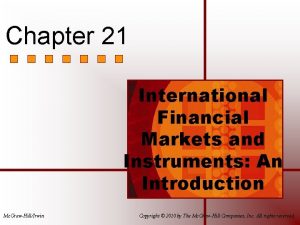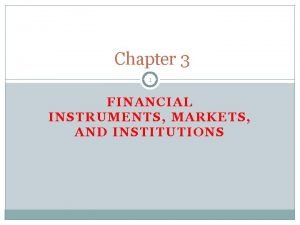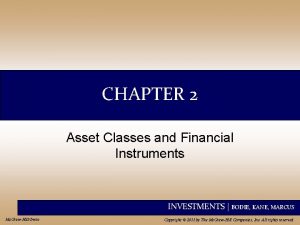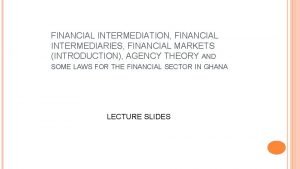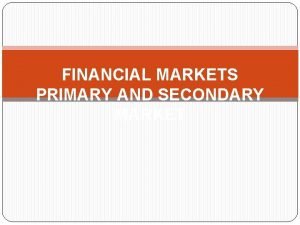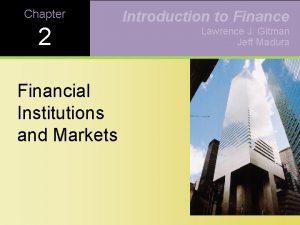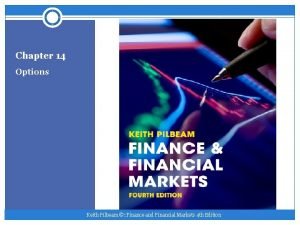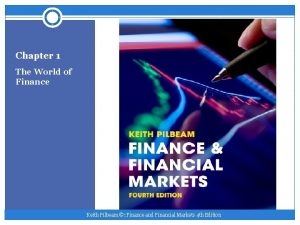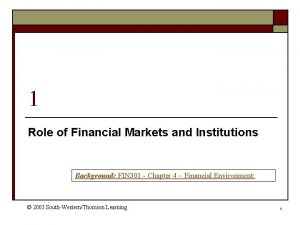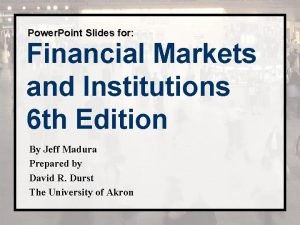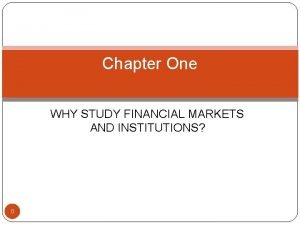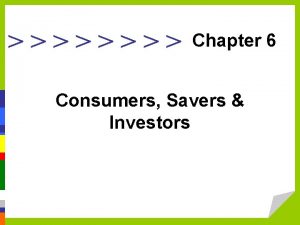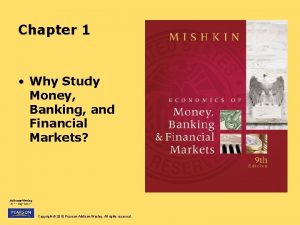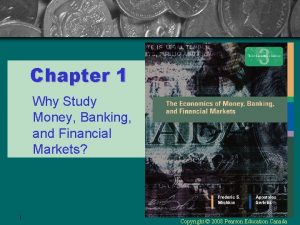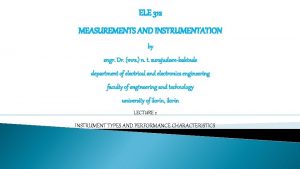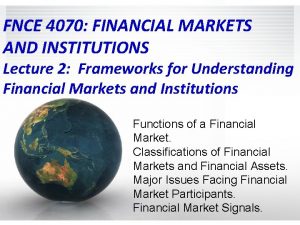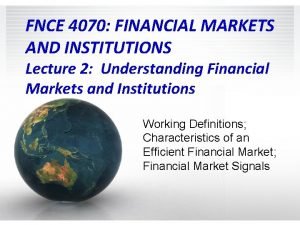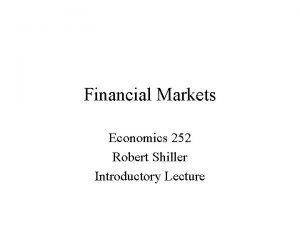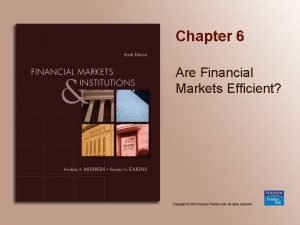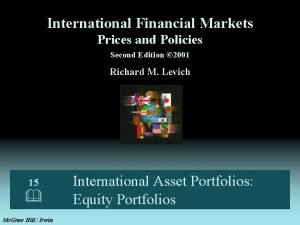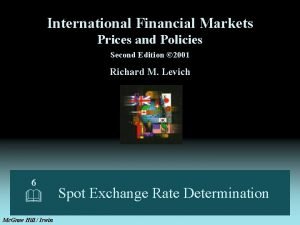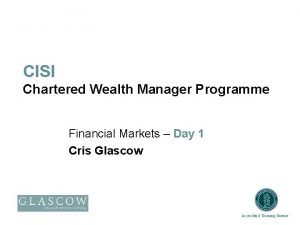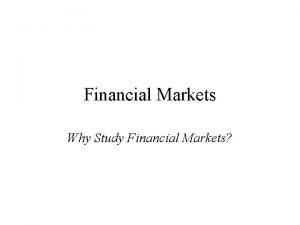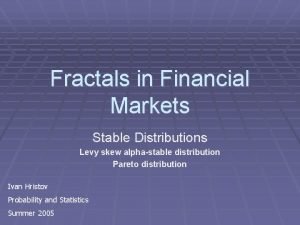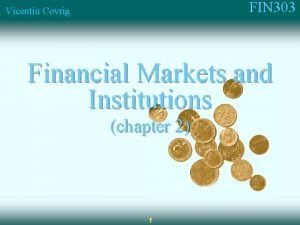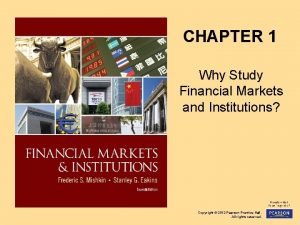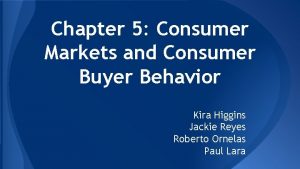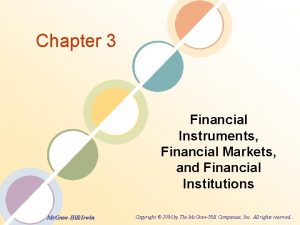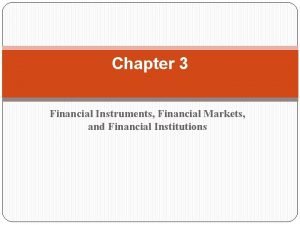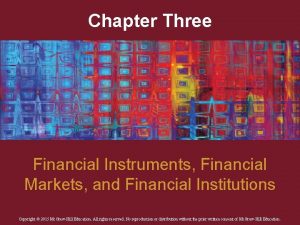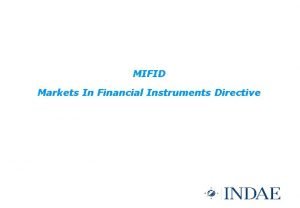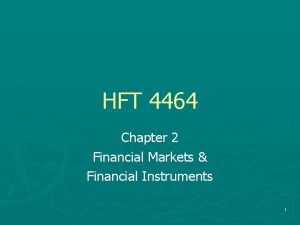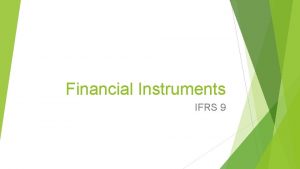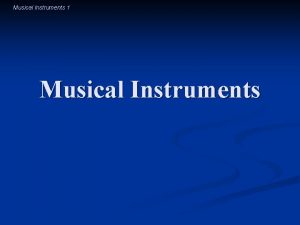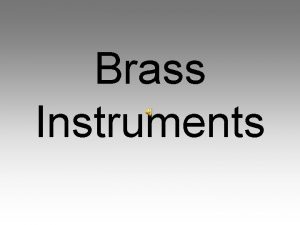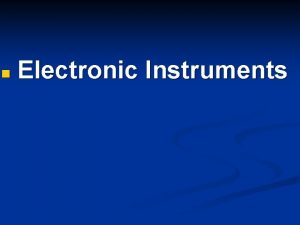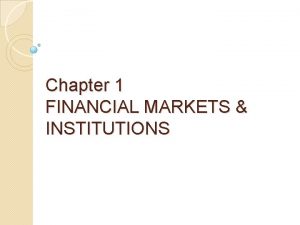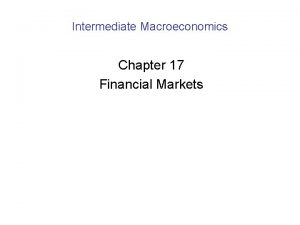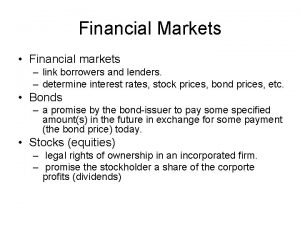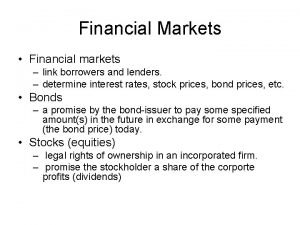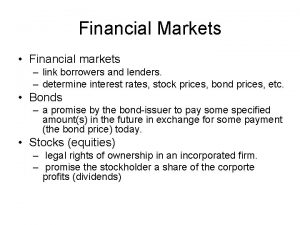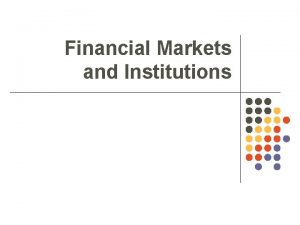Chapter 6 Financial Markets Instruments and Participants 2000









































- Slides: 41

Chapter 6 Financial Markets, Instruments, and Participants © 2000 South-Western College Publishing 1

Money Market The market for financial assets with an original maturity of less than one year 2

Capital Market The market for financial assets with an original maturity of greater than one year 3

Term to Maturity The length of time from when a financial security is initially issued until it matures 4

Primary Market The market in which a security is initially sold for the first time 5

Secondary Market The market in which previously issued financial securities are sold 6

Spot Market in which the trading of financial securities takes place instantaneously 7

Financial Futures Markets Organized markets that trade financial futures agreements 8

Speculation The buying or selling of financial securities in the hopes of profiting from future price changes 9

U. S. Treasury bills (T-bills) Short-term debt instruments of the U. S. government with typical maturities of 3 -12 months 10

The Principal Money Market Instruments Amount Outstanding, End of Year Billions of Dollars Type of Instrument 1960 1970 1980 1997 Treasury Bills $37 $76 $200 $482 $430 Negotiable CDs 0 45 260 N. A Commercial Paper 5 35 99 558 979 Banker’s Acceptances 1 4 32 52 12 Repurchase Agreements 1 and Fed Funds 22 102 324 653 20 68 N. A. 145 Eurodollars 1 11 Exhibit 6 -1

The Money Market Typical Maturities Instrument • Treasury Bills 3 to 12 months • Negotiable CDs 1 to 6 months • Commercial Paper 1 to 270 days • Banker’s Acceptances 90 days • Repurchase Agreements 1 day, and 2 day to 3 months typical; 6 months less typical and Fed Funds • Fed Funds Chiefly 1 business day • Eurodollars Overnight, 1 week, 1 to 6 months and longer Exhibit 6 -2 a 12

The Money Market Principal Borrowers Instrument • Treasury Bills U. S. Government • Negotiable CDs Depository Institutions • Commercial Paper Financial & Business Firms • Banker’s Acceptances Financial & Business Firms • Repurchase Agreements and Fed Funds • Fed Funds Banks, Securities, nonfinancial firms, governments Depository Institutions • Eurodollars Banks Exhibit 6 -2 b 13

The Money Market Secondary Market Instrument • Treasury Bills Very Active • Negotiable CDs Modest Activity • Commercial Paper Moderately Active • Banker’s Acceptances • Repurchase Agreements and Fed Funds Limited None, but very active primary market for short maturities • Fed Funds Active broker’s market • Eurodollars None Exhibit 6 -2 c 14

Treasury Bills Days to Maturity Sept 24 ‘ 98 62 Oct 01 ‘ 98 69 Oct 08 ‘ 98 76 Oct 15 ‘ 98 83 Oct 22 ‘ 98 90 Oct 29 ‘ 98 97 Nov 5 ‘ 98 104 Nov 12 ‘ 98 111 Bid Asked Chg Ask. Yld 4. 86 4. 91 4. 96 4. 95 4. 83 4. 93 5. 00 5. 01 4. 84 4. 89 4. 94 4. 81 4. 92 4. 98 4. 99 +0. 01 +0. 03 +0. 01 4. 95 5. 00 5. 01 5. 07 4. 94 5. 06 5. 12 5. 14 15

Negotiable Certificates of Deposit (CDs) • Certificates of deposit with a minimum maturity of $100, 000 that can be traded in a secondary market • First introduced by Citibank in 1961 16

Commercial Paper Short-term debt instruments issued by corporations 17

Banker’s Acceptances Money market instruments created in the course of international trade to guarantee bank drafts due on a future date 18

Goods Now Importer No Bankers’ Acceptance Exporter Cash Later Ca sh Transaction occurs with a bankers’ acceptance e m i u T o c ed Now s i t p ft D e c ra c A D Ca sh bank Lat er s nt La ter w o N Exporter Exhibit 6. 3 Cash Later Importer Acceptance Now Cash Now Investor 19

Repurchase Agreements Short-term agreements in which the seller sells a government security to a buyer with the simultaneous agreement to buy it back on a later date at a higher price 20

Federal (Fed) Funds Loans of reserves (deposits at the Fed) between depository institutions typically overnight 21

Eurodollars Dollar-denominated deposits held abroad 22

Exhibit 6 -5 Instrument Corporate Stock The Capital Market Typical Principal Maturities Borrowers ____ Secondary Market Corporations Very active for large corporations Mortgages 15 to 30 years Homeowners and other investors Moderately active Corporate Bonds 2 to 30 years Corporations Active U. S. Govt. Notes Bonds 2 to 10 yrs. 30 years U. S. Govt. Agency Securities Up to 30 years Municipals 2 to 30 years U. S. Government Very active U. S. Government Agency Some activity State & Local Governments Active 23

Stocks are. . . Equity claims that represent ownership of the net assets and income of a corporation 24

Mortgages Loans made to purchase single or multiple family residential housing, land, or other real structures, with the structure or land serving as collateral for the loan 25

The Principal Capital Market Instruments Amount Outstanding, End of Year Billions of Dollars 1960 1970 Corporate Stock $451 $906 $1, 920 $3, 530 $12, 958 Mortgages 142 297 965 3, 804 5, 288 Corporate & Foreign Bonds 75 167 319 1, 704 3, 421 U. S. Government Securities 178 156 394 1, 595 3, 804 U. S. Government Agency Securities 10 51 170 426 995 Municipal Securities 71 144 N. A. 1, 368 Type of Instrument Exhibit 6 -4 1980 1997 26

Corporate Bonds Long-term debt instruments issued by corporations 27

U. S. Government Securities Long-term debt instruments of the U. S. government with original maturities of 2 -30 years 28

U. S. Government Agency Securities Long-term bonds issued by various government agencies including those that support commercial, residential and farm real estate lending, and student loans 29

State and Local Government Bonds (Municipals) Long-term instruments issued by state and local governments to finance expenditures on schools, roads, etc. 30

Revenue Bonds used to finance specific projects with proceeds of those projects used to pay off bondholders 31

General Obligation Bonds that are paid out of the general revenues and are backed by the full faith and credit of the issuer 32

Money Rates Prime Rate- The interest rate that serves as a basis for quoting rates to customers; an indicator of the cost of business borrowing from banks Federal Funds Rate- The interest rate charged on overnight loans in the federal funds market; a sensitive indicator of the cost to banks of borrowing funds Treasury Bill Rate - The interest rate on Treasury bills; an indicator of borrowing money Discount Rate - The rate charged by the Federal Reserve Banks for loaning reserve asset deposits to depository institutions 33

Money Rates Federal Home Loan Mortgage Rate (Freddie Mac)- The interest rate on “Fannie Mae” guaranteed mortgages; an indicator of the cost of financing conventional residential housing purchases Federal National Mortgage Association Rate (Fannie Mae)- The interest rate on “Fannie Mae” mortgages; an indicator of the cost of financing conventional housing purchases London Interbank Offered Rate (Libor)- The interbank rate for dollar-dominated deposits in the London market among international banks; the interest rate that serves as a basis for quoting other international rates 34

Market Maker A dealer who links up buyers and sellers of financial securities and sometimes takes positions in the securities 35

Broker Person who arranges trades between buyers and sellers 36

Dealer • Person who arranges trades between buyers and sellers AND can be a principal in a transaction • A market maker 37

Bid Price The price at which a market maker is willing to buy securities 38

Asked Price The price at which a market maker is willing to sell securities 39

Market Makers Assist in raising funds to finance deficits by marketing a borrower’s new securities in the primary market Makers Advise potential buyers and sellers of securities on the course of action likely to minimize costs and maximize returns Exhibit 6. 6 Stand ready to buy or sell outstanding securities in the secondary market 40

The Marketing and Trading of a Corporate Bond APEI wants to issue bonds to finance investment Primary Merrill Lynch agrees (for a fee) to Market design a bond offering and to Activity market (sell) the bonds SSUs and financial intermediaries buy APEI bonds that will mature in 20 years One year later SSUs (or financial intermediaries) decide to sell some of their APEI Salomon Bros. Makes a market in APEI bonds by buying bonds from SSUs Secondary Market Activity Salomon sells “used” APEI bonds to another SSU 41 Exhibit 6. 7
 International financial markets and instruments
International financial markets and instruments Basic flow of funds through the financial system
Basic flow of funds through the financial system Why study financial markets and institutions?
Why study financial markets and institutions? Chapter 2 asset classes and financial instruments
Chapter 2 asset classes and financial instruments Financial intermediation ppt
Financial intermediation ppt Financial markets and institutions ppt
Financial markets and institutions ppt What is financial intermediation
What is financial intermediation Savers and investors role in financial markets
Savers and investors role in financial markets Primary vs secondary financial markets
Primary vs secondary financial markets Financial markets and the allocation of capital
Financial markets and the allocation of capital Foreign exchange and international financial markets
Foreign exchange and international financial markets Madura j. financial markets and institutions
Madura j. financial markets and institutions Pilbeam k. finance and financial markets
Pilbeam k. finance and financial markets Pilbeam finance and financial markets
Pilbeam finance and financial markets Primary vs secondary financial markets
Primary vs secondary financial markets Madura j financial markets and institutions
Madura j financial markets and institutions Why study financial markets and institutions
Why study financial markets and institutions Chapter 6 consumers, savers, and investors answer key
Chapter 6 consumers, savers, and investors answer key Why study money banking and financial markets
Why study money banking and financial markets Why study money banking and financial markets
Why study money banking and financial markets Difference between active instrument and passive instrument
Difference between active instrument and passive instrument Pressure measuring devices
Pressure measuring devices Classification of financial markets
Classification of financial markets Classification of financial markets
Classification of financial markets Shiller financial markets
Shiller financial markets Classification of financial markets
Classification of financial markets Classification of financial markets
Classification of financial markets Are financial markets efficient
Are financial markets efficient Levich international financial markets
Levich international financial markets Levich international financial markets
Levich international financial markets Chartered wealth manager cisi
Chartered wealth manager cisi Classification of financial markets
Classification of financial markets Fractals in financial markets
Fractals in financial markets Well functioning financial markets
Well functioning financial markets Why study financial markets
Why study financial markets Characteristics of consumer behavior
Characteristics of consumer behavior Chapter 9 expanding markets and moving west
Chapter 9 expanding markets and moving west Business markets and business buyer behavior
Business markets and business buyer behavior Business buyer behavior refers to the
Business buyer behavior refers to the Chapter 5 consumer markets and buyer behavior
Chapter 5 consumer markets and buyer behavior Chapter 9 expanding markets and moving west
Chapter 9 expanding markets and moving west Chapter 9 expanding markets and moving west
Chapter 9 expanding markets and moving west
